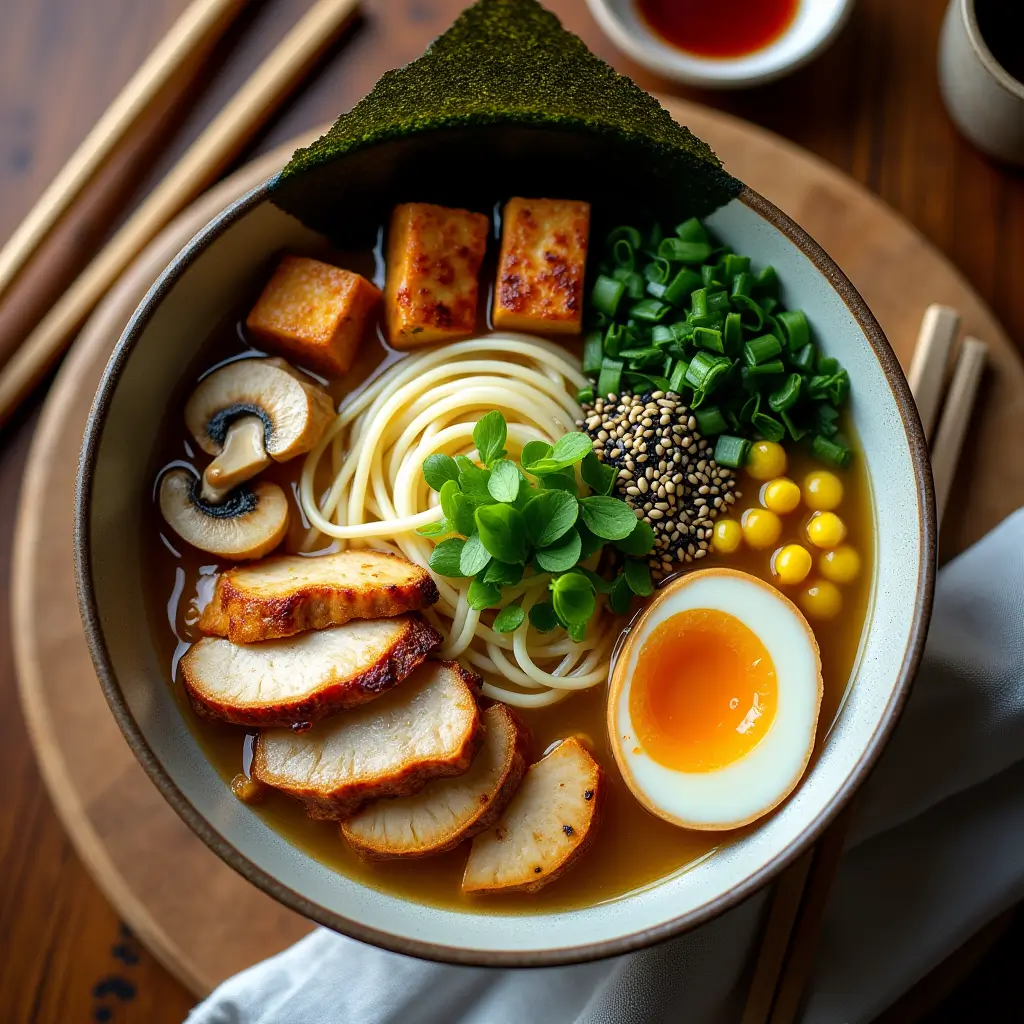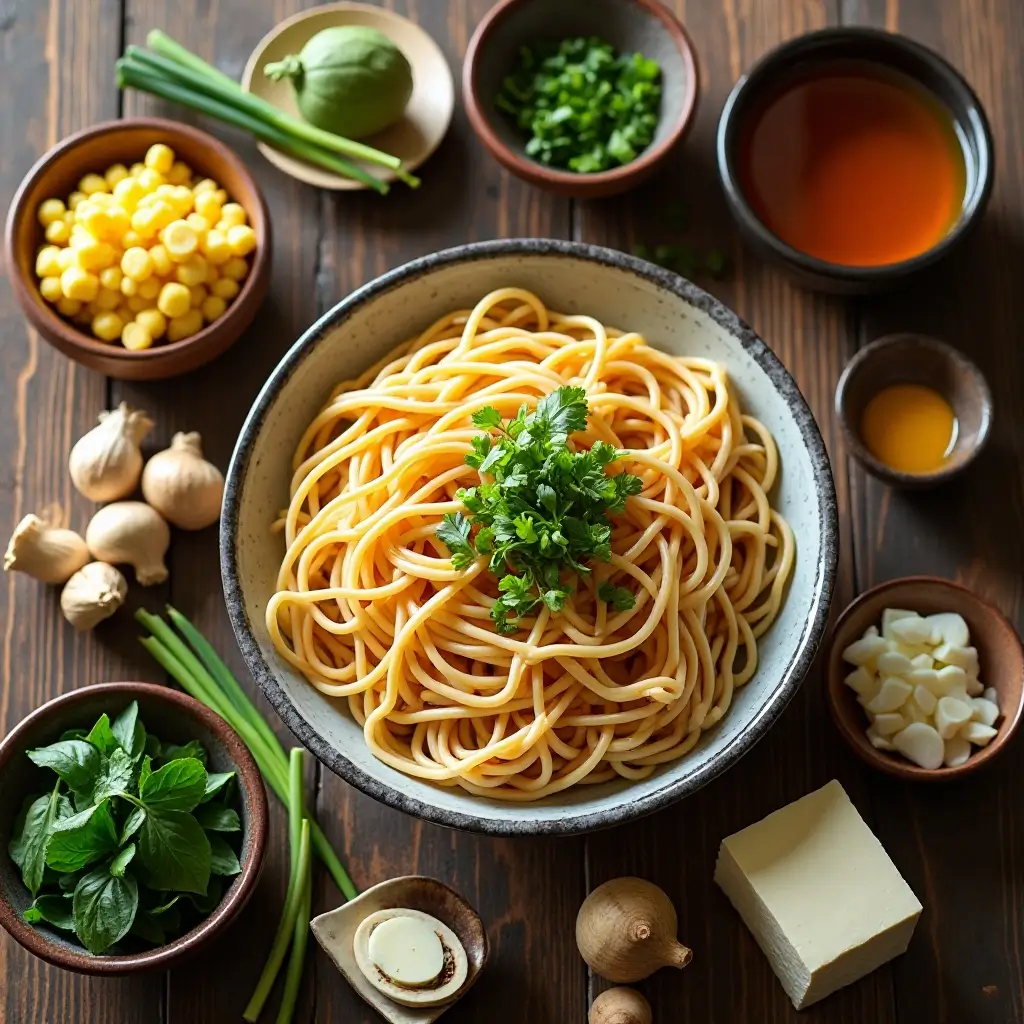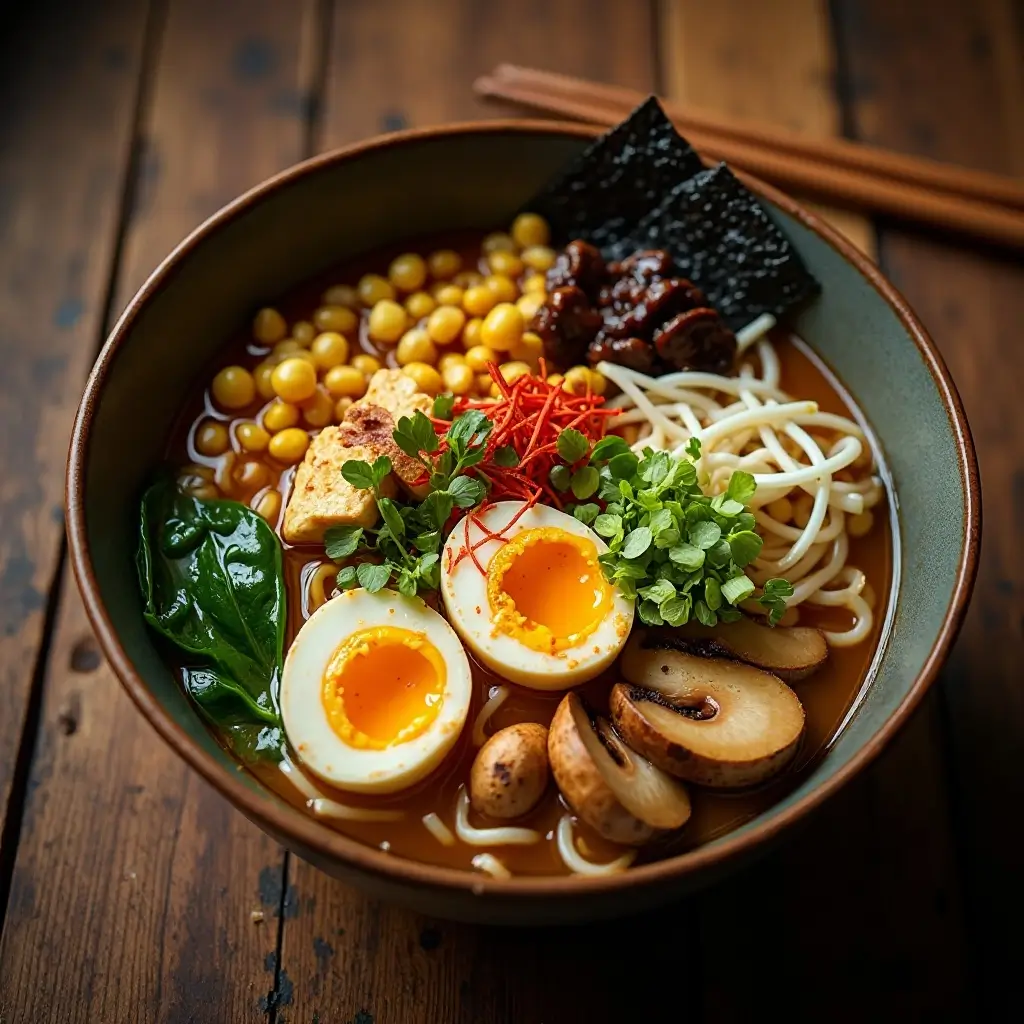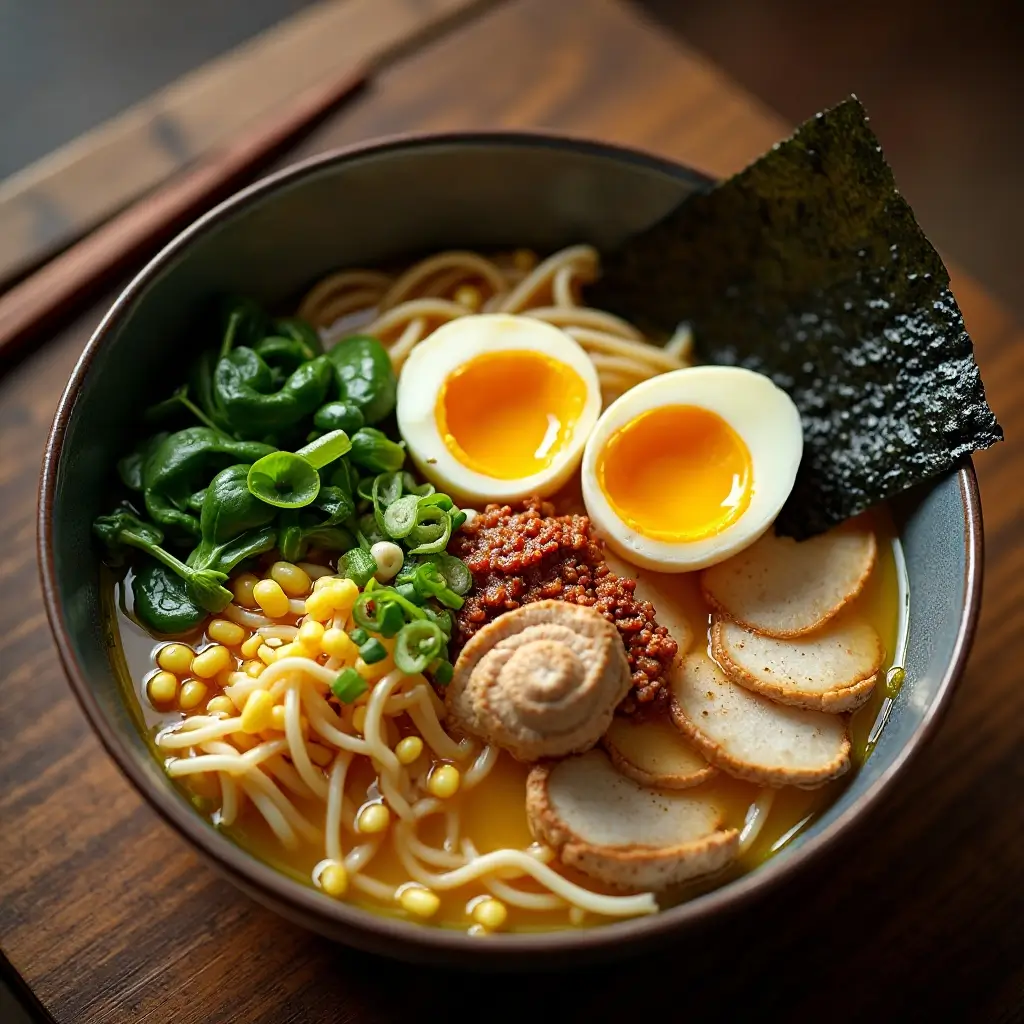Simple Ramen Noodle Bowl Recipe
Making a perfect ramen noodle bowl recipe at home doesn’t have to be hard or take hours. This simple guide will show you how to create restaurant-quality ramen bowls right in your kitchen. With just 15 minutes and basic ingredients, you’ll have a warm, satisfying meal that beats any takeout option.
Table of Contents
What Makes This Ramen Noodle Bowl Recipe Special?
This ramen noodle bowl recipe stands out for so many reasons. First, it’s incredibly fast – you can have a steaming bowl ready in just 15 minutes. That’s perfect for busy weeknights when you need something quick but filling.
The best part is how budget-friendly this recipe is. You probably already have most ingredients in your pantry. Basic items like soy sauce, garlic, and eggs create amazing flavors without breaking the bank. A homemade bowl costs less than half of what you’d pay at a restaurant.
This recipe is also super flexible. Whether you eat meat, follow a vegetarian diet, or have food allergies, you can easily adapt this ramen noodle bowl recipe to fit your needs. Swap proteins, change vegetables, or adjust spice levels – it all works perfectly.
The final result tastes just like expensive restaurant ramen. Rich, flavorful broth, perfectly cooked noodles, and fresh toppings come together for an amazing meal that will impress everyone at your table.

Essential Ingredients for Your Ramen Noodle Bowl Recipe
Base Ingredients
Every great ramen noodle bowl recipe starts with quality base ingredients. Fresh ramen noodles work best, but dried noodles from the Asian grocery store are excellent too. Avoid instant ramen packets – they don’t have the right texture for this recipe.
For broth, you have several options. Chicken broth creates a rich, savory base that most people love. Vegetable broth works perfectly for plant-based versions. Miso paste mixed with hot water makes an authentic Japanese-style broth with deep umami flavors.
Aromatics are crucial for building flavor. Fresh garlic and ginger add warmth and depth to your broth. Scallions (green onions) provide a fresh, mild onion taste that brightens the entire bowl.
Protein Options
Soft-boiled eggs are the classic protein for any ramen noodle bowl recipe. They’re creamy, rich, and add beautiful color to your bowl. Cook them for exactly 6-7 minutes for perfectly runny yolks.
Grilled chicken work wonderfully if you want more substantial protein. Season them with soy sauce and garlic before cooking for extra flavor. Leftover roasted meats work great too.
For vegetarian versions, firm tofu is your best friend. Pan-fry it until golden for better texture and taste. Other plant-based proteins like tempeh or seitan also work well in this flexible recipe.
Fresh Toppings and Vegetables
Corn kernels add sweetness and bright color to your ramen noodle bowl recipe. Use frozen corn – just thaw it first. Bean sprouts provide nice crunch and fresh flavor. You can find them in most grocery stores’ produce section.
Mushrooms bring earthy, rich flavors that complement the broth perfectly. Shiitake mushrooms are traditional, but button or cremini mushrooms work fine too. Sauté them lightly before adding to your bowl.
Leafy greens like spinach or bok choy add nutrition and color. They cook quickly in the hot broth, so add them right before serving. Nori sheets (seaweed) give an authentic Japanese touch and mild ocean flavor.
Flavor Enhancers
Soy sauce is essential for authentic ramen flavor. Use low-sodium versions if you’re watching salt intake. Miso paste adds complex, fermented flavors that make your broth taste like it simmered for hours.
Sesame oil provides nutty richness – just a few drops make a huge difference. Chili oil or sriracha sauce add heat and depth for spice lovers. Rice vinegar brightens all the flavors and adds subtle tang.

Step-by-Step Instructions for Perfect Ramen Noodle Bowl Recipe
Preparing the Broth Base
Start by heating 4 cups of broth in a medium saucepan over medium heat. Add minced garlic and ginger to build your flavor foundation. Let them simmer gently for 2-3 minutes until fragrant.
Season your broth with 2-3 tablespoons of soy sauce and 1 tablespoon of miso paste if using. Taste and adjust – your broth should be flavorful but not too salty. Remember, you’ll add more flavors with toppings.
Keep your broth hot but not boiling. High heat can make it cloudy and harsh-tasting. A gentle simmer maintains the best flavor and appearance for your ramen noodle bowl recipe.
Cooking the Noodles
Bring a separate pot of water to boil for your noodles. Fresh ramen noodles usually cook in 2-3 minutes, while dried noodles need 4-5 minutes. Check the package directions, but test for doneness yourself.
Perfect ramen noodles should be tender but still have a slight bite. They’ll continue cooking a bit in the hot broth, so slightly undercook them. Overcooked noodles get mushy and ruin the texture.
Drain noodles immediately when done. Don’t rinse them – you want to keep some starch for better broth adhesion. Divide cooked noodles between your serving bowls right away.
Preparing Toppings
For soft-boiled eggs, bring water to boil, gently add room-temperature eggs, and cook for exactly 6-7 minutes. Transfer to ice water immediately to stop cooking. Peel carefully when cool.
Quick-cook your vegetables by adding them to the simmering broth for just 1-2 minutes. Spinach needs only 30 seconds, while harder vegetables like carrots need longer. Remove with a slotted spoon.
If using meat, cook it separately and slice thinly. Pre-cooked proteins can be warmed in the broth briefly, but don’t overcook them or they’ll become tough.
Assembly and Presentation
Place cooked noodles in deep bowls first. Pour hot, seasoned broth over noodles, making sure to cover them completely. This keeps noodles warm and helps them absorb flavors.
Arrange toppings artfully on top of your ramen noodle bowl recipe. Place halved soft-boiled eggs cut-side up to show the golden yolk. Add vegetables in sections for beautiful color contrast.
Garnish with sliced scallions, a sprinkle of sesame seeds, and a few drops of sesame oil. Serve immediately while everything is hot for the best eating experience.

Expert Tips for Elevating Your Ramen Noodle Bowl Recipe
Broth Enhancement Techniques
The secret to restaurant-quality broth is layering flavors. Start with good-quality stock, then build complexity with aromatics, seasonings, and time. Even 5 extra minutes of simmering improves flavor significantly.
Add umami-rich ingredients like dried mushrooms, kombu seaweed, or a splash of fish sauce. These ingredients boost savory flavors without making your ramen noodle bowl recipe taste fishy or strange.
For richer texture, whisk in a small amount of tahini or peanut butter. This creates a creamy, restaurant-style broth that coats noodles beautifully.
Noodle Selection and Preparation
Fresh ramen noodles have better texture and flavor than dried ones, but good dried noodles work fine. Look for noodles labeled “chuka soba” or “ramen” at Asian grocery stores for authentic results.
Cook noodles in unsalted water to prevent them from getting too salty when combined with seasoned broth. Save some pasta water – it can help adjust broth consistency if needed.
Never let cooked noodles sit in water or they’ll get mushy. Have your broth ready before you start cooking noodles for perfect timing in your ramen noodle bowl recipe.
Advanced Topping Ideas
Marinated eggs (ajitsuke tamago) take your bowl to the next level. Soak peeled soft-boiled eggs in soy sauce, mirin, and sake for 4-24 hours for amazing flavor and color.
Fermented vegetables like kimchi or pickled bamboo shoots add tangy, complex flavors that complement rich broth perfectly. Start with small amounts and adjust to taste.
Popular Variations of This Ramen Noodle Bowl Recipe
Spicy Ramen Bowl
Transform your basic ramen noodle bowl recipe into a fiery feast by adding chili paste or fresh chilies to your broth. Start with 1 teaspoon and increase gradually – you can always add more heat.
Make homemade chili oil by heating neutral oil with dried chilies, garlic, and ginger. This creates complex heat that’s more flavorful than just adding hot sauce.
Balance spicy heat with cooling ingredients like corn, soft-boiled eggs, or a dollop of sour cream. The contrast makes both flavors more enjoyable.
Vegetarian and Vegan Options
Create amazing plant-based versions using vegetable broth and miso paste for depth. Nutritional yeast adds cheesy, umami flavors that make vegan ramen incredibly satisfying.
Replace eggs with marinated tofu or tempeh. Pan-fry until golden for better texture. Shiitake mushrooms provide meaty texture and rich flavor that meat-eaters will love.
Use coconut milk for creamy richness in vegan versions. Just add a few tablespoons to your broth for restaurant-quality creaminess without dairy.
Regional Style Adaptations
Make tonkotsu-inspired ramen by adding a splash of heavy cream to chicken broth.
Miso ramen variation uses different types of miso paste for unique flavors. White miso is mild and sweet, while red miso adds deeper, saltier notes to your ramen noodle bowl recipe.
Shoyu-style preparation focuses on clear, soy sauce-based broth with delicate flavors. Use light soy sauce and add extra aromatics like ginger and scallions.

Nutritional Benefits of Homemade Ramen Noodle Bowl Recipe
| Nutrient | Per Serving | % Daily Value |
|---|---|---|
| Calories | 450-550 | 22-28% |
| Protein | 20-25g | 40-50% |
| Carbohydrates | 55-65g | 18-22% |
| Fat | 12-18g | 18-28% |
| Fiber | 4-6g | 16-24% |
| Sodium | 800-1200mg | 35-52% |
| Iron | 3-4mg | 17-22% |
| Vitamin A | 15-25% | 15-25% |
Making ramen at home lets you control nutrition much better than restaurant versions. You can reduce sodium, add more vegetables, and choose lean proteins for healthier meals.
Fresh vegetables provide vitamins, minerals, and fiber that packaged ramen lacks completely. Eggs add high-quality protein and healthy fats. Even simple additions make this ramen noodle bowl recipe nutritionally complete.
Homemade versions typically have 30-50% less sodium than restaurant ramen. You control salt levels in broth and toppings, making it heart-healthier while maintaining great taste.
Make-Ahead and Storage Tips
Meal Prep Strategies
Prepare components separately for easy weeknight assembly. Cook proteins, chop vegetables, and make soft-boiled eggs up to 3 days ahead. Store everything in airtight containers in the refrigerator.
Make large batches of seasoned broth and freeze in portions. Ice cube trays work great for small amounts. Thaw overnight in the refrigerator, then reheat when ready to serve your ramen noodle bowl recipe.
Pre-portion dry ingredients like sliced scallions, corn, and nori sheets in small containers. This makes assembly super quick when you want ramen fast.
Freezer-Friendly Options
Broth freezes perfectly for up to 3 months. Cool completely before freezing to prevent ice crystals. Leave space in containers for expansion during freezing.
Cooked proteins like chicken freeze well sliced and portioned. Thaw in refrigerator overnight, then warm briefly in hot broth before serving.
Don’t freeze cooked noodles or fresh vegetables – they get mushy when thawed. Always cook these components fresh for best texture in your ramen noodle bowl recipe.
Troubleshooting Common Ramen Noodle Bowl Recipe Issues
Bland broth is the most common problem with homemade ramen. Fix this by adding more soy sauce, miso paste, or salt gradually. Taste frequently while adjusting – you can’t remove salt once added.
Mushy noodles happen when they’re overcooked or sit too long in broth. Cook noodles separately and add to bowls just before serving. Time everything so noodles finish when broth is ready.
Unbalanced flavors need adjustment with acid, salt, or sweetness. Add rice vinegar for brightness, soy sauce for depth, or a pinch of sugar to round out harsh flavors.
Temperature problems occur when components aren’t hot enough. Heat bowls with warm water before assembly, and make sure broth is steaming hot when poured over noodles.
Serving Suggestions and Pairings
Serve your ramen noodle bowl recipe with simple side dishes that won’t compete with complex flavors. Steamed dumplings, edamame, or cucumber salad work perfectly as light accompaniments.
Green tea, iced tea, or light beer pair wonderfully with ramen. Avoid heavy drinks that might overwhelm delicate broth flavors. Sparkling water with lemon cleanses the palate between bites.
Plan for generous portions – ramen is meant to be a complete meal. One large bowl per person is usually plenty, especially with protein and vegetables included.
For family-style serving, put toppings in separate bowls so everyone can customize their ramen noodle bowl recipe. This makes the meal interactive and fun for all ages.
Frequently Asked Questions About This Ramen Noodle Bowl Recipe
Can I use instant ramen noodles?
While fresh or dried ramen noodles work best, you can use instant noodles in a pinch. Discard the seasoning packets and cook noodles according to package directions. The texture won’t be quite as good, but the flavors will still be delicious.
How long does homemade ramen last?
Store components separately in the refrigerator for best results. Broth lasts 3-4 days, cooked proteins last 3 days, and prepared vegetables last 2-3 days. Never store assembled ramen – noodles get mushy quickly in liquid.
What’s the best broth substitute?
If you don’t have traditional broth, try bouillon cubes dissolved in hot water, or even hot water with soy sauce and miso paste. Bone broth works excellently too. The key is having enough flavor base to season properly.
Can I make this recipe gluten-free?
Yes! Use gluten-free ramen noodles (rice noodles work well) and tamari instead of soy sauce. Check that your miso paste is gluten-free too. All other ingredients in this ramen noodle bowl recipe are naturally gluten-free.
How do I achieve restaurant-quality results?
The secret is high-quality broth, proper noodle cooking, and fresh toppings. Don’t skip aromatics like garlic and ginger. Use real sesame oil, not imitation. Most importantly, serve immediately while everything is hot for the best experience.
Final Thoughts: Mastering Your Homemade Ramen Noodle Bowl Recipe
Making perfect ramen at home is easier than you think. Focus on building flavorful broth, cooking noodles properly, and using fresh toppings. Don’t be afraid to experiment with different combinations until you find your favorite version.
This ramen noodle bowl recipe is just the starting point for your culinary adventures. Try different proteins, vegetables, and seasonings. Make it spicier, add more vegetables, or create fusion versions with ingredients from other cuisines.
Share your creations with friends and family – homemade ramen makes people happy and brings them together. Take photos of your beautiful bowls and inspire others to try making this amazing comfort food at home. Once you master this basic recipe, you’ll never want takeout ramen again!
